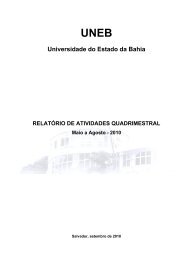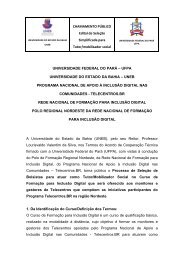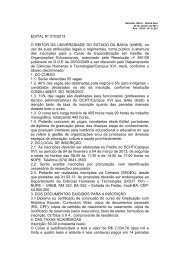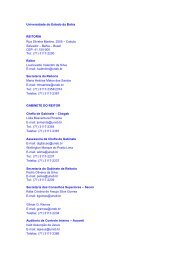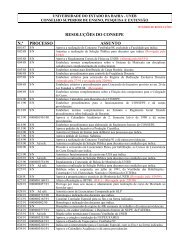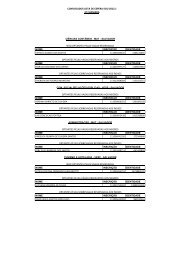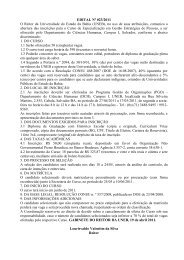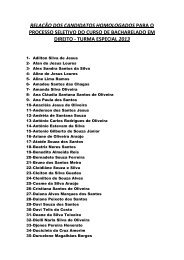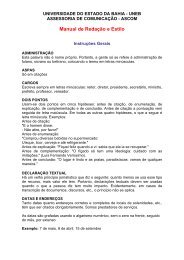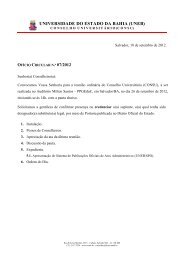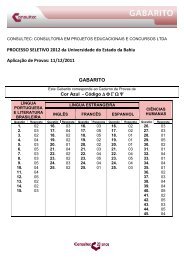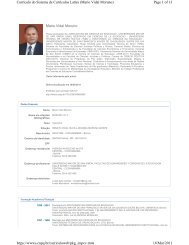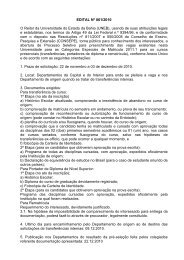Revista da FAEEBA Educação e Contemporaneidade - Uneb
Revista da FAEEBA Educação e Contemporaneidade - Uneb
Revista da FAEEBA Educação e Contemporaneidade - Uneb
Create successful ePaper yourself
Turn your PDF publications into a flip-book with our unique Google optimized e-Paper software.
In search of América: latina/os (re)constructing the U.S.A.<br />
process” (1990, p.222). Challenging the national<br />
ideology of monoculturalism and assimilation,<br />
and forcing Euro-Americans to<br />
confront their own checkered past, they have<br />
encountered powerful opposition in the process.<br />
“Producing” themselves within the nation-state,<br />
they have contributed to a<br />
re-defining of what it means to be American.<br />
The “Latinization” of the U.S. goes beyond<br />
cross-over artists, food, and music that have<br />
entered the mainstream; these are only the<br />
most visible elements of a nation in transition.<br />
Latinos are forging cross-national alliances,<br />
revitalizing spent urban areas, remaking<br />
urban ethnoscapes (DAVIS, 2001). “AmeRícan,”<br />
proclaims Nuyorican poet Tato Laviera:<br />
254<br />
REFERENCES<br />
AmeRícan defining myself my own way any way<br />
many<br />
ways Am e Rícan, with the big R and the<br />
accent on the í (1985, p. 95)<br />
As always, the U.S. is being “reinvented”<br />
from forces within and without. But these new<br />
realities co-exist with a nostalgia for an idealized<br />
past. What remains to be seen is whether<br />
“America becoming 24 ” will embrace the diversity<br />
and potential of the growing numbers of<br />
Latinos and become the nation that it has so<br />
long claimed to be. The “threat” to the nation<br />
for the foreseeable future will not be Latinos,<br />
but rather the failure of the national will to create<br />
a more equitable 25 and just society that can<br />
deliver on the promise that is America.<br />
ACUÑA, Rudolfo. Occupied America: A History of Chicanos. (3a ed.). New York, NY: Harper & Row, 1988.<br />
ANZALDUA, Gloria. Borderlands/La Frontera: The New Mestiza. San Francisco, CA: Spinsters/Aunt<br />
Lute.<br />
APPADURAI, Arjun. Disjuncture and Difference in the Global Cultural Economy. Public Culture, v. 2, n. 2,<br />
p. 1-24, 1990.<br />
_____. Global Ethnoscapes: Notes and Queries for a Transnational Anthropology. In: FOX, R. (Org.).<br />
Recapturing Anthropology: Working in the Present. Santa Fe, NM: School of American Research Press,<br />
1991, p. 191-210.<br />
BALLVE, Marcelo. Regaining Mexican Citizenship – New California Media, 2003. Available at: . Accessed on 5 July 2004.<br />
BIGLER, Ellen. American Conversations: Puerto Ricans, White Ethnics, and Multiculturalism. Philadelphia,<br />
PA: Temple University Press, 1999.<br />
BRIMELOW, Peter. Alien Nation: Common Sense about America’s Immigration. New York, NY: Random<br />
House, 1995.<br />
BUCHANAN, Patrick. Commentary on HUNTINGTON, Samuel, The Hispanic Challenge. Available at: . Accessed on 12 July 2004.<br />
BUSTOS, Sergio. Hispanics Dislike Label. Gannett News Service. Available at: . Accessed on 14 July 2004.<br />
CRAWFORD, James. Bilingual Education: History, Politics, Theory and Practice. Los Angeles, CA: Bilingual<br />
Education Services Inc., 1995.<br />
24 The phrase “America Becoming” was used as part of the title of a report on the state of racial relations and racial equity<br />
in the U.S., commissioned in the 1990s by then-President Bill Clinton<br />
25 A review of statistical <strong>da</strong>ta underlines the critical nature of this situation. Almost twenty-two percent (21.9) of Hispanics<br />
live below poverty level (2004), compared to 8.6 percent of non-Hispanic whites. Information available at , accessed September 6, 2006. Only<br />
57 percent of Hispanics have a high school or beyond education (2003) compared to 89 percent of non-Hispanic whites.<br />
Information available at , accessed<br />
September 6, 2006.<br />
<strong>Revista</strong> <strong>da</strong> <strong>FAEEBA</strong> – <strong>Educação</strong> e Contemporanei<strong>da</strong>de, Salvador, v. 15, n. 25, p. 239-257, jan./jun., 2006



